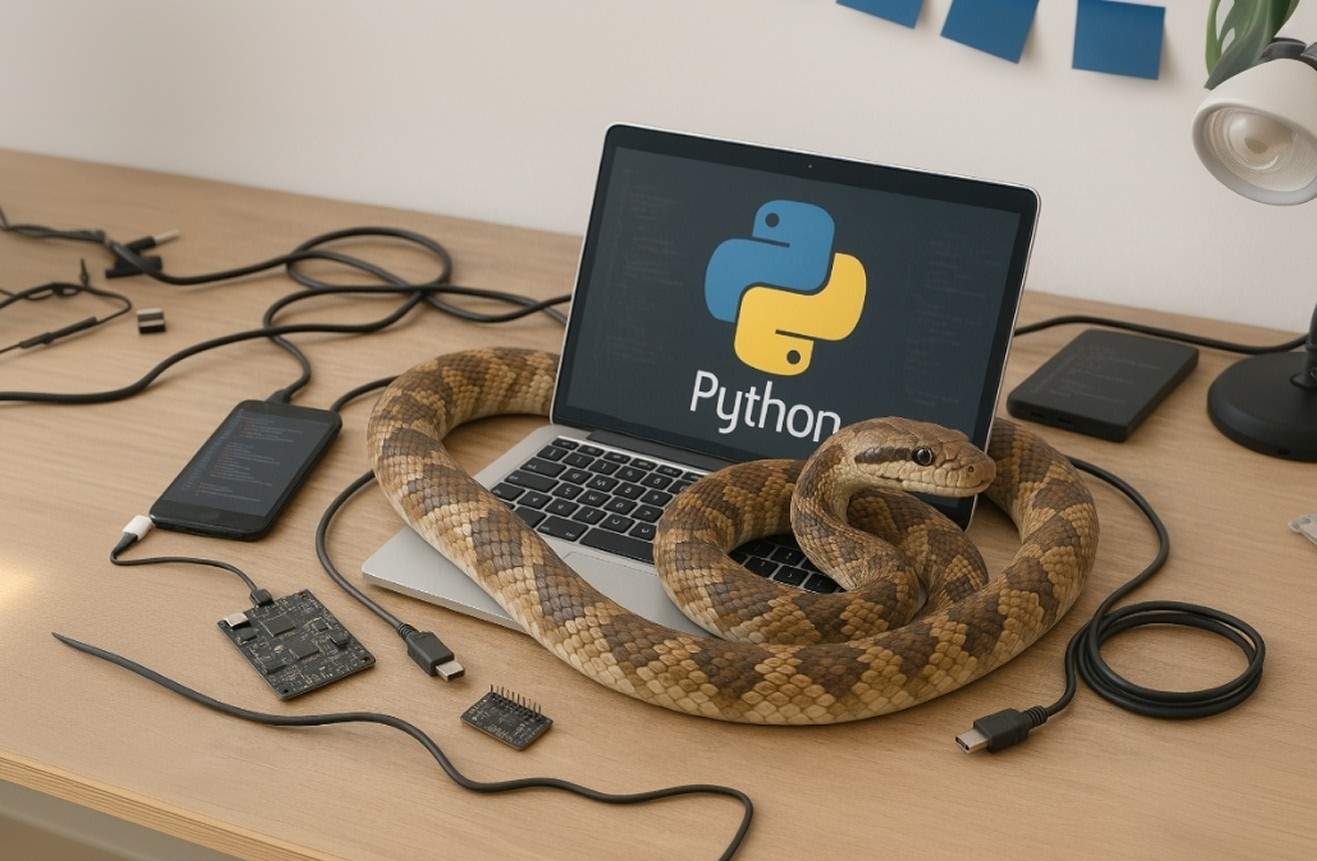You need to try hard to be in tech and never hear about Python. One can encounter it everywhere, be it quick scripts, machine learning, web backends, or even mobile tools. But honestly, is Python good for app development if you are talking mobile?
If you want the easy answer, it’s yes. But the language is in no way an ultimate solution, so do not treat it like that. However, when used with proper frameworks and architecture, it can be a solid choice.
So, if you ever thought about using Python in mobile app development, this article is for you. In it, we’ll take a look at seven reasons that actually make it a solid choice from a practical standpoint and also in what cases its use should be avoided.

If you want to know if Python is a good match for your app project, we are here to help.
Reason #1: Python is unmatched for rapid prototyping.
If speed to market matters (and let’s be honest, when doesn’t it?), Python gives you a head start. Its clean syntax and minimal boilerplate make it ideal for rapidly building out app logic and testing features.
For startups building MVPs or teams validating new features, Python app development can be a major win. Instead of getting bogged down in verbose syntax or complex configuration, you get to focus on actual functionality.
Take Instagram, for example. Its backend runs on Python, and the team used the language to quickly scale internal tools during rapid growth phases. While the mobile frontend isn’t Python-based, the speed Python offered on the backend helped keep development cycles tight.
Reason #2: Cross-platform tools like Kivy and BeeWare make Python mobile-ready.
Python isn’t a native language for Android or iOS, and no one should pretend it is. But with tools like Kivy and BeeWare, developers can still create cross-platform mobile apps using Python.
Kivy lets you build multitouch applications with a natural UI across desktop and mobile. It’s not the prettiest out of the box, and it won’t match Swift or Kotlin in performance, but it works. For internal tools, hobby projects, or educational apps, it’s more than capable.
BeeWare takes a different approach. It allows you to write your app in Python and then compile it into a native iOS or Android app. Python for app development for such purposes is still maturing, but it’s promising, especially for teams that already use Python across the stack.
When Python mobile makes sense:
- Simple UIs or MVPs
- Cross-platform internal tools
- Apps tightly integrated with Python-based backends or AI/ML pipelines

Reason #3: Python is built for AI, data, and logic-heavy applications.
Let’s say your app isn’t just a pretty front end. It crunches numbers, recommends content, or processes user data. This is where Python app development really shines.
With libraries like TensorFlow, PyTorch, scikit-learn, and pandas, Python is the gold standard for data science and machine learning.
Apps that use intelligent recommendations, behavioral modeling, or predictive analytics often rely on Python at the core. Consider Spotify’s song recommendations or Uber’s dynamic pricing systems. While their mobile apps are native, much of the decision-making logic runs through Python pipelines.
Use Python when:
- You need a strong backend brain behind the app.
- Your app is part of a larger data-driven system.
- You’re working with ML, NLP, or complex business logic.

Reason #4: Python simplifies backend development with frameworks like Django and Flask.
Not every mobile app is mobile-first. Many modern apps, including SaaS platforms and internal enterprise systems, are web-first or fully browser-based.
For those use cases, Python is an excellent backend choice. Django provides an efficient, scalable framework that handles routing, templating, ORM, and security out of the box. It’s used by giants like Pinterest and Mozilla.
For leaner, more flexible builds, Flask is a lightweight microframework that gives you control without the overhead.
Why this matters? If you’re building an app with a Python backend and a mobile/web frontend (using React, Vue, or Flutter), the backend language won’t limit your frontend options. And when it comes to managing user accounts, business logic, or content workflows, Python delivers.
Reason #5: Python plays well with cloud platforms and APIs.
Python has first-class support on major cloud platforms like AWS, GCP, and Azure. It’s also the language of choice for many API-first services, including OpenAI, Stripe, and Twilio, all of which provide Python SDKs for rapid integration.
If your app relies on multiple APIs, serverless functions, or microservices, Python offers:
- Easy authentication handling
- Clean async support with asyncio and FastAPI
- Readable, testable integration code
In short, if your app’s strength is in orchestration, not UI flash, Python fits.
Reason #6: The ecosystem is mature and well-supported.
One of the biggest selling points of Python app development is its maturity. Python has been around for over three decades, and during that time it’s amassed one of the largest and most helpful developer communities on the internet.
This means:
- You have answers to your stackoverflow questions.
- You have libraries for nearly every niche.
- Security updates and versioning are handled responsibly.
Plus, the Python Package Index (PyPI) hosts over 500,000 packages. You’re rarely starting from scratch, which shortens development time and reduces bugs.

Reason #7: It’s ideal for teams who value readability and collaboration.
App development is rarely a solo effort. Code gets handed off, revisited, audited, and debugged. And Python’s readable syntax makes that easier, especially for teams that span designers, developers, analysts, and QA engineers.
While performance-intensive apps might favor languages like Rust or Swift, Python excels when human collaboration matters. Whether it’s onboarding a junior dev or debugging with a product owner, Python makes it easier to work together.

When Not to Use Python for App Development
Let’s be real: Python is not a silver bullet. And claiming it’s the best for development of all mobile apps would be misleading.
Avoid using Python when:
- You need high-performance graphics or animation (e.g., 3D games or video editing apps);
- You want pixel-perfect native UI on iOS or Android;
- You require access to the latest mobile OS features (widgets, ARKit, etc.);
- App size and performance are non-negotiable.
In these cases, go native (Swift for iOS, Kotlin for Android) or use Flutter or React Native for cross-platform builds.

Final Thoughts
So, is Python good for app development? In many ways, absolutely. It’s flexible, readable, and powerful, especially when building data-driven apps, MVPs, web services, or intelligent backends. It’s not going to win awards for UI fluidity on mobile, but it can still play a meaningful role in your app’s architecture.
If your team already uses Python, or if your app relies heavily on AI, APIs, or web-first workflows, Python app development can be both practical and efficient. Just be honest about where it fits and where it doesn’t. Because the best apps aren’t just well-designed. They’re built on the right foundation for the problem they’re solving. And in the right hands, Python is a solid part of that foundation.
Frequently Asked Questions
You can, but with caution. Python isn’t a native language for iOS or Android, so you’ll need frameworks like Kivy or BeeWare for cross-platform development. These tools are great for internal apps, MVPs, or data-heavy tools but may fall short for performance-intensive or highly polished consumer apps.
Python shines most when used for:
- Backend development (with Django or Flask)
- AI/ML-powered features (via TensorFlow, PyTorch, etc.)
- Rapid prototyping or MVPs
- APIs and cloud orchestration
- Apps requiring heavy data processing or logic
No. In performance-intensive apps like 3D games or video processing tools, Python performs poorly. Better to use native languages like Swift or Kotlin, or engines like Unity or Unreal Engine.
Yes, in most cases. Python frameworks don’t offer full access to the latest native features (e.g., ARKit, widgets, native camera APIs). If your app needs cutting-edge hardware integration, go for native development.
Absolutely. Many modern apps use Python for backend services (e.g., user management, AI, analytics) and pair it with React Native, Flutter, or native code for the frontend. This hybrid approach is both practical and powerful.
Yes, especially for enterprise tools, SaaS platforms, and data-driven systems. Python’s mature ecosystem, extensive libraries, and community support make it ideal for scalable enterprise solutions.
Depending on your goals:
- Use Swift (iOS) or Kotlin (Android) for native apps
- Use Flutter or React Native for high-quality cross-platform apps
- Choose Rust, Go, or Node.js for performance-focused backends
Python apps tend to have larger footprints and slower performance compared to native apps. This trade-off is acceptable for internal tools, prototypes, and data-centric apps, but less so for polished consumer applications.
Yes, particularly for building MVPs quickly and affordably. Python’s fast development cycle and readable codebase help small teams iterate and validate ideas faster — a big advantage in early-stage development.


















